A few years ago, I spent two months in the jungles of Peru. That experience gave me a new appreciation for all the uses of a survival machete.
It would have been impossible to get through some of the thick overgrowth if we didn’t have a good machete to hack the vines!
Even now, I’m constantly finding new uses for a machete in the states.

Let’s dive straight into our top picks.
 SOG SOGfari Kukri Machete
SOG SOGfari Kukri Machete
Best machete for those who want an affordable, entry-level blade for light tasks.
Machete Comparison Table
| Style | Product Name / Product Image | Length | Weight | Primary Button |
|---|---|---|---|---|
|
Survival All-Rounder
|
|
|
|
|
|
For Beginners
|
|
|
|
|
|
|
|
||
|
|
|
||
|
|
|
||
|
|
|
Top Survival Machetes Reviewed
Ka-Bar Kukri Machete
By our rating, this is one of the best machetes around; Ka-Bar has delivered a gorgeous product. It is made from 1085 carbon steel with a black epoxy powder coating.
The rubberized Kraton handle fits well in your hand. Just be warned that the Kraton can cause blisters, so wear gloves when doing heavy-duty tasks.
My only mild complaint about the Ka-bar Kukri is that its sheath is a bit awkward to carry. The sheath does have a belt loop and end loops, but it still doesn’t sit well. Considering the low price, though, I can’t complain too much.
Kukris aren’t as strong as a bolo, but they do a good job chopping and cleaning small branches. At 17″ total length with handle, the Ka-Bar Kukri is a great campsite companion.
Pros
- 1085 carbon steel
- Non-slip Kraton handle
- Leather and Cordura sheath
- Edge holds up great
Cons
- Sheath sits a bit awkwardly
- Rubber handle can cause blisters
CRKT Ken Onion Halfachance 14” Parang Machete
The Halfachance machete certainly makes a strong first impression. Designed by Ken Onion, the machete looks mean and imposing. It is technically a parang-type machete but has the design elements of a Bowie.
As you’d expect from a Parang, the blade is thin at just 1/10th inch. This makes it suitable for clearing light brush and some camp tasks like carving wood. You won’t want to use this machete to chop thick wood, though.
The blade is made from 65MN carbon steel, which has a hardness in the mid-50s. This means it is a relatively low-hardness machete. The downside is that it will need sharpening more often. However, the low hardness means that sharpening is a lot easier. The softer steel also absorbs strikes better, meaning the blade is less likely to shatter if you accidentally hit a rock or nail.
As far as weight goes, the Halfachance is just 20.4oz. Again, not great for chopping – but it is excellent for people who are just learning to wield a machete or don’t have much core strength.
The main downside of the Halfachance Parang is that it has finger grips. I don’t like these. Unless your fingers fit the grips perfectly, your fingers can be in an uncomfortable, improper grip. However, some people prefer finger grips as they reduce slippage.
Note that the Amazon listing for this machete is a bit confusing. The machete has different blade lengths, but the listing title says “18 inches” for all of them. The Halfachance is 14″ long. The Chanceinhell version is 18″.
Pros
- Easy to resharpen
- Holds edge decently
- Powder coating prevents corrosion
- Great price
Cons
- Not suitable for heavy work
- Finger grooves might not fit your hand well
- Fairly short blade
SOG SOGfari 18″ with Saw Back
I honestly didn’t expect much out of such a cheap machete. However, the SOGfari delivers well on quality. The blade is a classic Latin/Bush-style.
The long, uniform blade is good for efficiency – and especially great if you aren’t used to swinging a machete.
The SOGfari comes in two sizes: 13″ and 18″. I would only go with the 18″. It has more swinging power and doesn’t feel bulky to carry.
The saw back has offset teeth as a hand saw. As with any saw-back machete, sawing through branches can be awkward because of the handle shape. However, you can get through 5″ branches relatively easily.
Note that this is a low-budget machete. For the price, it’s great. Just don’t expect too much from the 420 steel (which has almost no carbon). Thus, I’d recommend the SOGfari for newbies wanting to get a feel for survival machetes.
Pros
- Aggressive saw back
- Serrated edge on handle for breaking glass
- Low price
Cons
- Chips easily on rocks
- Heavy at 1.8lbs
- Belt loop a bit flimsy
- 420 stainless steel, not very tough
Condor Parang 17.5 inch
The Parang machete by Condor is an excellent blade for thinning out thick brush or even saplings.
At 17.5 inches, the blade might seem like it would be too long. However, it is very well-balanced. The only issue is that the parang blade is relatively thick, making it heavy for its style.
If you aren’t experienced in using machetes or don’t have much thick brush to clear, you might want to choose a lighter machete.
Pros
- Gorgeous design
- Hardwood handle
- 1075 high-carbon steel
- Holds edge very well
- Leather sheath included
Cons
- A bit pricey
- Two-snap sheath is annoying to use
- Better for slicing and pounding than chopping
- Fairly heavy (1.92lbs)
Schrade SCHBOLO Bolo
While they aren’t as popular as Gerber and SOG, Schrade makes great quality blades at very good prices. They’ve got quite a few survival machetes, and I had difficulty choosing the best.
I love their Bolo machete because it has the perfect curve. Remember, a Bolo blade’s bulging shape allows for better distribution of force and more cutting surface. Though relatively short at 14 inches, the blade whacks right through branches. You could quickly chop up a big log with this machete.
At 4mm, the blade is thick. Surprisingly, it still cuts through thin grass. I don’t think it would hold up well in jungle situations because of all those vines, but it is a good machete for forests.
Pros
- Insane chopping power
- Good weight (1.69 pounds)
- Heavy-duty sheath holds up well
- Sturdy 4mm blade
- Comes with sharpening stone and Ferro rod
Cons
- Gets dull quickly
- 3CR13 stainless steel
- Sheath has no belt loops
- 7.3 inch handle not great for small hands
Condor 15″ Engineer Bolo Machete
The Condor Engineer Bolo machete has been around for a long time. Unlike most Bolo machetes which are mid-weight, this one is a beast. It weighs 2.54lbs and has a 3/16″ thick blade, which is great for chopping through wood.
It is not great, however, for clearing brush. Your body would quickly tire from swinging it around!
The curvature of the blade is made well. When you hit wood, the weight of the blade goes through the curve to maximize chopping. Again, this is great for heavy-duty tasks!
As for the blade material, it is a 1075 high carbon steel. The steel holds its edge well, even against harder wood. Hard steel does mean you need to be careful not to hit any nails or rocks, though. Another issue is that the high-carbon steel will rust. Make sure you clean the machete and store it properly! I wouldn’t recommend using this machete in humid places.
Some other nice aspects of the Engineer Machete are the gorgeous finish, durable leather sheath, and wood handle. All of these features are pointless, though, if you don’t plan on doing lots of chopping. And, if you are only going to use it for chopping, maybe you’d be better off with an axe.
Pros
- Great for heavy-duty tasks
- Holds edge well
- Beautiful finish
- Durable leather sheath
Cons
- Rusts easily
- Too heavy for many tasks
- Handle is a bit short
Uses for a Good Machete
Big and robust, the machete is a very versatile type of blade. It is something between a sword, cutlass, and survival knife. Some go as far as calling machetes “the only multi-tool you’ll ever need.”
I still like my small EDC multi-tools, but I have a machete with my survival gear.
Machete Uses
- Clearing a campsite
- Stripping bark and shoots from branches
- Lawn mowing
- Pruning trees and bushes
- Splitting wood
- Making a shelter
- Killing snakes as they are about to strike
- Self-defense
- Making a snow cave
- Chopping compost
- Carving notches into wood
- Butchering large game
- Driving nails
- Opening beer bottles
- Opening nuts
Bear in mind that there are a lot of types of machetes. A machete might be able to do all of this, but it won’t necessarily do it well.
You’ve got to consider how you will use the machete before you buy it. Then you can make sure you get the best machete for your needs.
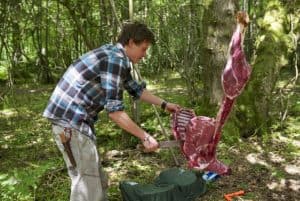
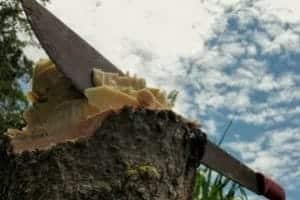

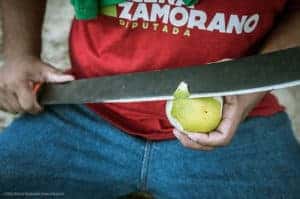
Types and Blade Shapes
When you start looking at machetes, you’ll see that they come in all sorts of shapes and sizes. These styles make them suited for different purposes. To figure out what style is right for you, consider the following:
- Blade thickness: Thin machetes are made to slash through lighter bush without straining your arm (think clearing a grassy campsite). Thicker machetes can hack through huge branches – but the weight will give your arms a major workout!
- Blade curve: Some machetes (such as the kukri) have very drastic curves. The curve increases the contact area of the blade, making it ideal for chopping. Curved blades are also suitable for slashing, making them a formidable weapon. By contrast, a straight edge is better for thrusting.
- Blade Tip: Pointed tips are great for tasks like skinning game. However, pointed tips aren’t as strong. Rounded blades are better for clearing thick bush or chopping through wood.
Most Popular Types
Kukri

My favorite type of survival machete, the kukri, has three parts.
The first part is the pointed tip, which makes it a good self-defense weapon.
The second part is the curved mid-area, which is ideal for cutting through thick bush.
Finally, the area near the handle is suitable for detailed work.
The only issue is that these are heavy, so your arm will be killing you after a day of clearing.
Latin/Bush

The long, thin shape of the Latin machete helps it stay balanced. Thus, it is relatively easy to perform tasks with the Latin machete. It serves as a good multi-tool.
Just don’t expect it to do demanding tasks efficiently – it’s too thin and pointed.
Bolo

The bolo is an excellent all-around machete. The rounded shape adds strength for challenging tasks, but the blade is thin enough for lighter work.
Bowie

The main feature of the Bowie machete is its clip-point blade. This blade makes it ideal for skinning game. The point makes the edge weaker, so don’t expect to do much chopping with a bowie.
Panga

I consider the panga to be the fiercest-looking of all machetes. It is commonly used in Southern Africa as a weapon.
Some are made so both sides can be sharpened, meaning it will slice through game (or disembowel someone) fairly quickly. The curvature makes it suitable for slicing as well as light chopping.
Parang or Golok

Parang and golok machetes are two types with very similar features. They have beautiful, sleek curves, but the entire blade is narrow.
Because these blades are thick, they are still solid and great for cutting through thick brush.
Spetsnaz

These were made by the Soviets during WWII and are still used by Russian Special Forces today.
The machete was designed to be a heavy-duty chopping tool, which is why the blade is so thick and heavy.
A Spetsnaz is tough to sharpen and not balanced. However, a lot of people love them as collector’s items.
Which Machete Type to Get?
The type of machete you get depends on where you live and what kind of vegetation or wood you will cut through.
Here’s a general breakdown of the best machete based on how it will be used.
- Cutting through Thin Underbrush: The Latin and Bolo machetes are suitable for this because they have thinner blades, making it easier to go through thin brush without straining yourself.
- Clearing Thick Brush: You’ll need a machete with a thicker blade to go through thicker brush. The Parang and Golok are good choices. The Kukri also works well because its curved blade can hook branches.
- Chopping Wood: You want a machete with a heavier, thicker blade for chopping work. A Spetsnaz is ideal for this. The Bolo and Panga machetes are also good options, and a Golok or Parang can do lighter chopping work.
- Butchering Game: Machetes with thin, pointed blades like the Bowie are what you need for butchering game.
- Shaping Wood: It depends on what you want to shape, but generally, you’ll need a very thin, light blade to shape wood effectively. A Bush or Latin machete is great for this. You can also use a Kukri – the part of the blade near the handle is shaped for splicing/carving wood.
- Combat/Self-Defense: Combat machetes need to be able to slice effectively. The double-sided Panga machete will undoubtedly do this. You’d also want a longer machete blade to keep more distance between you and your attacker, so a long Latin or Bolo machete could work. If you have more skill, the Kukri is great for stabbing or cutting the head off an attacker!
Best Multi-Purpose Machete Type
If you need the best machete to accomplish many different tasks (or aren’t sure how you’ll be using your machete), then I’d recommend going with a Kukri.
The Kukri is used in Central Asia as a military weapon but also handles many other camp tasks. The blade shape gives you a lot of versatility.
You’ll be able to use it for chopping, clearing vegetation, and even whittling.
Quick Note about Clearing Briars with a Machete.
Many people want to get a machete for clearing through briars or thorny things like blackberry bushes. While this is possible with a machete, it is not your best choice.
When you swing a machete at a briar, the briar might whip around and smack you in the face. You’ll also likely end up hitting the ground a lot – which means hitting rocks and damaging your blade.
A better choice for briars is a brush hook with a large handle. Or get a pair of sharp snips with a long-handled rake to push them aside.
Other Machete Features
Once you’ve learned about the types of machete (blade styles), the other features are the same as when choosing a knife:
- Tang: The tang is the part of the blade that extends into the handle. Cheap machetes will have thin tangs which are glued into the handle. The best machetes have full tangs attached with bolts and are much sturdier.
- Blade Material: Natives will make their own machetes out of scrap metal. When buying a machete, you’ll want to look for high-quality, strong steel or carbon steel.
- Length: In general, machete blades are very long. Some are longer than others, making them more efficient at clearing bush and effective as weapons – but are much heavier to carry.
- Handle Material: While wood handles are often considered best, this is a personal preference. I like rubberized handles for their non-slip grip, but they wear out quickly.
- Pommel: The pommel is the end of the blade. Flat pommels are great if you want to use them for hammering.
- Extras: Depending on your needs, you might want a machete with a saw-back or gut hook.
Sheaths
Some cheap survival machetes come without a sheath. While locals living in the jungles of South America and Asia might be able to get by without a sheath, you will probably want one!

If the machete you want doesn’t come with a sheath (or a sheath in the material you want), make sure you can easily find one. Machetes are specifically shaped, so you can have a hard time finding a sheath to fit – and it costs a lot to special order one!
As far as materials go, leather sheaths are preferred. However, nylon sheaths are also good options for a fraction of the cost. Also, pay attention to whether there are belt loops for carrying.
Tips for Proper Use
When using a machete, you should NOT get blisters, sore arms, or an aching back. Unfortunately, there is a bit of a learning curve for using a machete. So expect to deal with these problems at the beginning.
While blisters are manageable, you don’t want to risk getting any worse injuries.
Please take the time to learn about proper machete form and technique before hacking away at some brush!
Here are some basics about machete technique to get you started.
Gripping the Machete
A common mistake is griping a machete with a “death grip.” Your grip should be somewhat loose.
Start by wrapping your thumb and pointer finger around the machete, making the “OK” sign around it. These fingers should be tightly gripped.
Wrap your remaining three fingers around the handle. These fingers remain loose.
If you are getting sweaty, wear gloves with the machete or even use a lanyard to attach the handle to your wrist. This will prevent the machete from slipping out of your hand (causing you to lose a toe!).
Machete Form
Here is where it helps to have a solid core! Contrary to what many think, you should be swinging the machete from your core, not your back or arms.
Start by lowering your shoulder. Then swivel your core back. Twist your core forward, whipping your arm (with the machete in it) downward. The downward action is crucial because it allows the machete to do the work. You get the weight of the machete and gravity on your side.
Your elbow should be leading as your arm whips around. Your wrist will flick at the very last moment before you make contact with what you are chopping.
The motion is a lot like skipping rocks across water. It is NOT like chopping with an axe!
Getting the Proper Angle
This takes a lot of practice to master. I recommend that you chop/cut slowly with your machete when you first start. This will help you build up good form so learn to instinctively hit at the right angle.
Doing this will save you a lot of strain and wasted energy.
- Chopping: For chopping wood, you need to hit it at a 45-degree angle. You do NOT want to hit it at a perpendicular angle. The machete will get stuck. You continue chopping in alternative 45-degree angles, making V notches.
- Clearing brush or cutting grass: You also need to use a 45-degree angle for brush or grass. You’ll use longer slashing motion, though.
This video shows why the angle is so crucial for cutting with a machete.
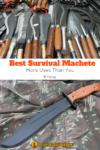

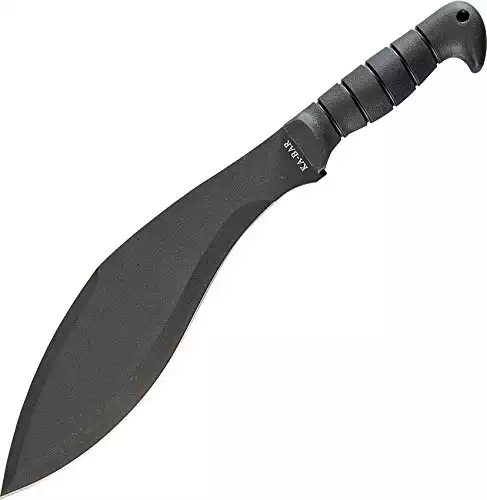
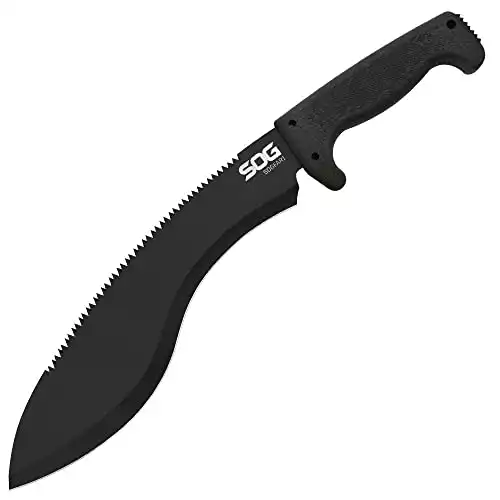
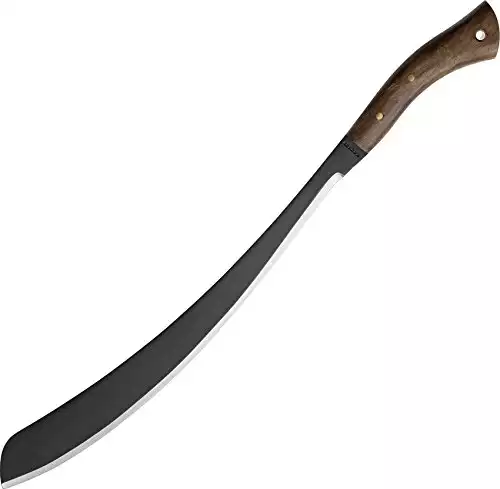
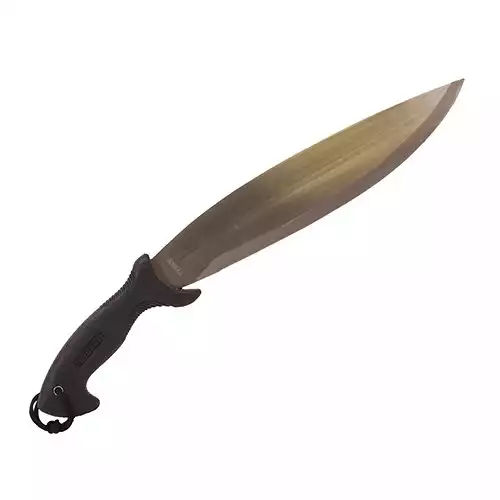
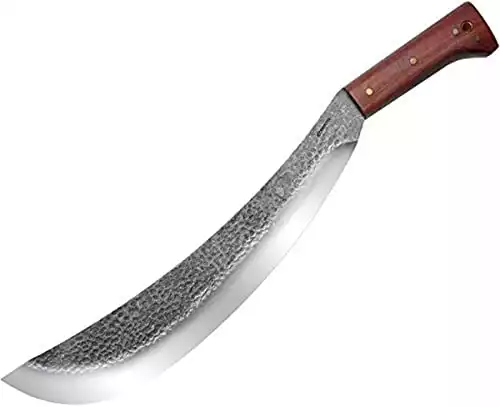
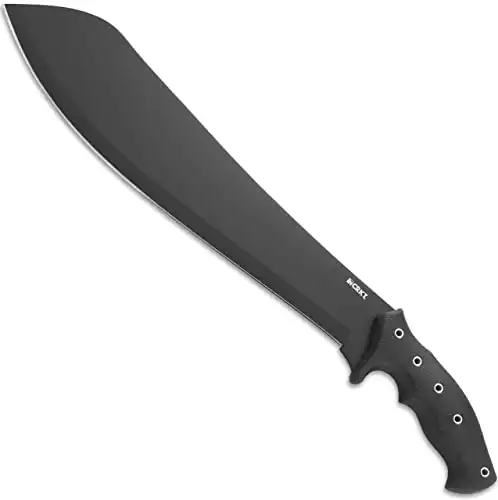




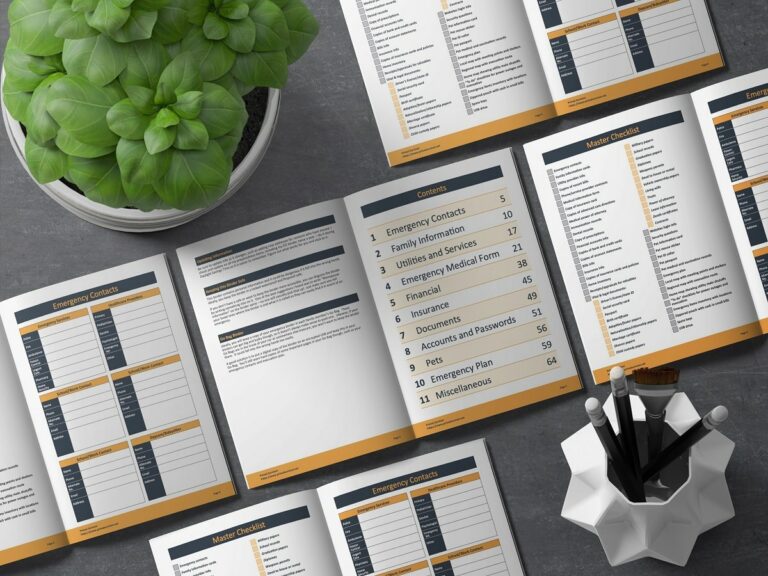

“…great for stabbing or cutting the head off an attacker!”
Right. And how many people would actually be capable of beheading a person?
Machetes can be great tools for dissuasion though. And dissuasion is MUCH better than exposing yourself to a fight with a bloody and gory and potentially extremely painful outcome for you as well as for your adversary.
So, let’s start with the basics.
1) BE ALERT and learn to avoid putting yourself into unsafe situations
2) When a threat cannot be avoided, desescalation and dissuasion will usually do the job of keeping you safe. Calmly talk to the ones that are menacing you. Use your listening and observation skills (what do they want, what are their weaknesses) and show them that you are no easy prey and that they Will be putting themselves in danger to get what they want from you. Now is a good time to show that beautiful machete you just bought.
3) Usually there is no number 3, for your would-be attackers will have moved on to easier prey. If not, it’s good to know a few self defense techniques…and not just from books or the internet but by actually training in using them.
Conclusion : Better safe than sorry …or having to chop off heads like they do in the movies, ha ha.
Nice article… I have an original 1917 USMC Bolo that has served me for the last 50 years, and my father before me.
An excellent reproduction can be found here: US Model 1917 Bolo Knife with Scabbard
Not cheap, but then just how much is a life worth?
One more thing. I like the website, seems like you know your stuff has good content. Great article informative.
I have a ka-bar kukri for a few years it takes whatever I throw at it I have it pairs up with a more bushcraft black. I have the mora attached to the sheath of the kukri. The kukri is attached to my back pack so it’s always with me. I have ether a tops barkimo or the Coldsteel SRK in V3 steel on my belt like them both so have a hard time deciding witch one to leave on the BOB. I also carry a bow saw blade in a can so I can make wood frame for bigger logs or trees have a silky gomeboy folding saw on my belt for the smaller stuff. Working on my BOB Vehicle 1985 bronco and a utility trailer set up also. Thats the fun part of Emergency preparedness.
My favorite has always been a 1917 US Army Bolo https://www.bing.com/images/search?q=Us+Military+Bolo+Knife&FORM=IRIBEP
My uncle brought several home after service in the Philippines’ just after WWII, past down from my father. Still available on many sites and well worth the money you have to pay for a curio. Not unlike the original K-Bar…
Very sturdy! Excellent steel, tough but relatively easy to sharpen and holds an edge well. Well balanced in the hand.
I’ll take a Cold Steel shovel instead. With rare exceptions, you’ll do more digging, or sawing of bigger timber (than it makes sense to chop with a machete).
The Cold Steel is a readers favorite here – see our review post on survival shovels.
I would argue that the “Bowie machete” isn’t really a machete at all. It is just a very large novelty version of the traditional Bowie knife. It really isn’t very useful at all either as a machete or a knife.
I see a lot of people on “Naked and Afraid” carrying a kukri. However, seems they are the ones cutting themselves the most. For a jungle weapon, I can see the machete as a useful pick. But, in a more temperate climate, i would rather have a good bushcraft type of knife. Your article was interesting, though. I have a bolo machete.
Yes they are not for everyone, but can be invaluable in certain situations.